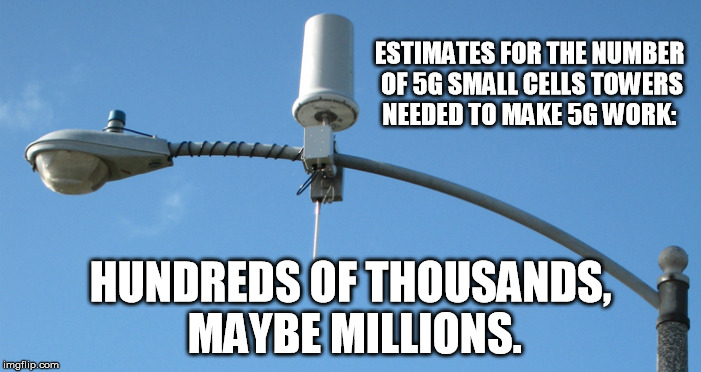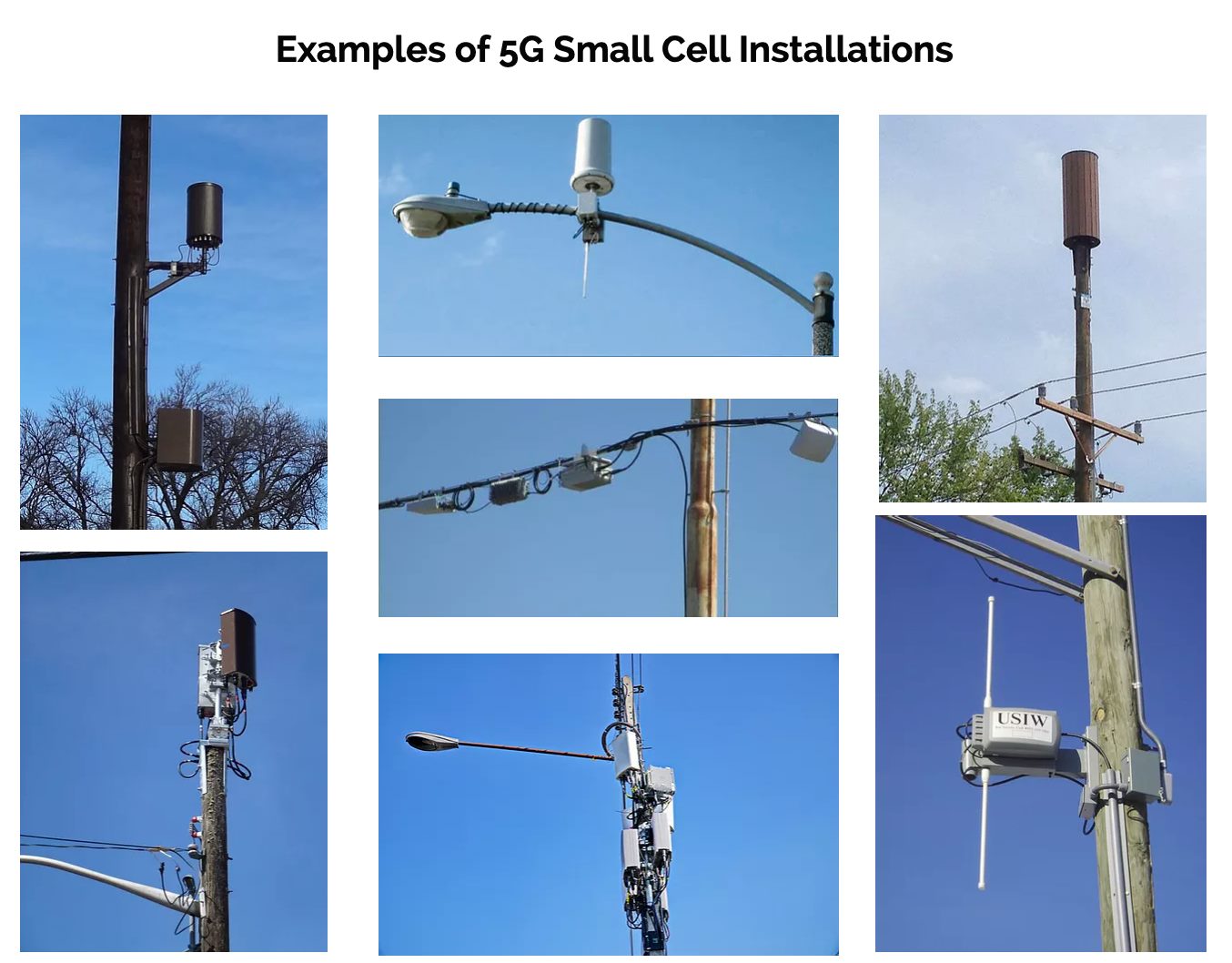 By B.N. Frank
By B.N. Frank
5G requires the densification of both 5G and 4G infrastructure. Over the years, experts have warned about how this will affect energy consumption (see 1, 2, 3, 4, 5, 6, 7, 8, 9).
Here’s another warning published by RCR Wireless:
Is powering small cells the greatest densification challenge?
CommScope director of engineering: ‘When densification [of small cells]increases […] so does the amount of power’
In the U.S., operators are expected to deploy five to 10 times more small cells than macro cells, and CTIA has forecasted that by 2026, more than 800,000 small cells will be deployed in the U.S., up from around 86,000 in 2018.
For Tom Craft, director of engineering, MetroCell Solutions at CommScope, this scale creates a problem: “Everything is focused on densification and getting services out to users, but when that densification increases by a factor of 10, so does the amount of power,” he said.
In fact, Craft believes that getting enough power reliably and cost effectively to the “tens, if not hundreds of thousands” small cells that will be deployed across the U.S. is the “biggest challenge” facing small cell densification.
Power availability for small cells
CommScope estimated in 2018 that the total time to deploy small cells is 18 to 24 months, due mostly to power constraints. According to the company, this timeline is a result of prioritizing coverage when designing new network sites, leaving power as an afterthought. Once the infrastructure design is in place and it is discovered that no electrical power exists nearby, approval to tap nearby buildings for power must be sought—a process that can take several months.
“We’re seeing today that it already takes months for the utility to get out there to turn power up on each one of those poles,” Craft continued. “And we see that problem only growing as the number of small cells increases not just from a connection standpoint, but from an operational or maintenance standpoint.”
Therefore, as these deployments go from small to large scale, CommScope is encouraging operators to pay attention to power, both from a planning and consumption perspective, and to do so early.
A typical three-sector small cell can require 200–1,000 watts of power, according to CommScope, and small cell networks must be incredibly dense to provide adequate coverage, meaning there will need to be a lot of individual installations, and each one will require power.
Power reliability for small cells
Worse, though, is the fact that the traditional model of powering a cell site — in which the site is powered by the AC power grid, with a backup power source available as a fallback— cannot be applied to small cells, as these sites do not currently come with power backup, and therefore, would go down during a power outage.
“The AC grid is known to have outages every year,” commented Craft, adding that once in place, people will begin to rely on these small cell systems for critical communication, making such outages potentially disastrous.
AC electrical feeds can be interrupted by a variety of anomalies from lightning strikes to blown transformers to rodent activity.
“The only way to fix that,” he continued, “is to have a centralized system that has some level of backup that keeps the system available in the traditional telecom network.”
The traditional telecom network reliability is around five nines today or 99.999% reliable, while the AC network can only claim around three nines, or 99.9% reliability.
“So, about .1% of the time the AC system is down and when the system is not available, that equates to a tremendous amount in cost, but also the loss of critical functions during things like storms when a phone is needed,” said Craft.
Power prices for small cells
The last piece of the power challenges, said Craft, is the rising cost of energy.
“We see that the cost is going to double in the next five years and then double again in another five years,” he claimed, citing market research.
He went on to explain that when you combine this information with the prediction that in 2025, the Information and communications technology (ICT) network will use about four thousand terawatt hours, you’re looking at an energy bill of roughly three hundred billion dollars for that year to run the network.
He added that while CommScope has yet to calculate what the cost of energy might be in 2030, it has been estimated that by that date, the ICT network will use about eight thousand terawatt hours, demonstrating the dire need to cut energy costs moving forward.
The good news, Craft continued, is that by leveraging advanced tools like artificial intelligence to manage those communications systems that will require more and more electricity— like small cells — those costs can be reduced.
From CommScope’s perspective, the other pressing power challenges faced by operators as they build out their small cell networks can only be solved by “centralizing the small cell layer as much as possible.”
“This means developing a power hub cabinet that boosts power and distributes that power from a centralized location,” Craft explained. “With our PowerShift Metro solution, for instance, we want to bring AC service to a single location within a small cell network, as opposed to going to multiple small cell site locations, each with individual meters or AC connection points. And then we distribute the power with fiber to each one of those small cell locations in that communications space.”
Craft further described the need to “balance centralizing and distributing small cells.”
“All the work that’s being done to distribute equipment out to the edge, there’s always a cost benefit for some level of centralization,” he said, adding that a centralized location for the distribution of power and connectivity for small cells, reduces cost for the number of components on each pole.
With fewer unknown variables to concern themselves with, operators have more control over how, when and where to add small cell coverage, allowing them to more swiftly respond to new market opportunities and reduce time to market.
To read more about small cells, check out What is a small cell, really?
 American opposition to both 4G and 5G densification (small cell and otherwise) continues to increase (see 1, 2). In addition to energy concerns, cybersecurity (see 1, 2, 3), privacy (see 1, 2, 3), public safety (see 1, 2, 3, 4, 5, 6, 7, 8, 9), health (see 1, 2, 3, 4, 5, 6, 7, 8, 9. 10), economic, and other environmental risks (see 1, 2) have been associated with deployment. In fact, lawsuits have been filed against 5G on Earth (see 1, 2, 3, 4) and in space.
American opposition to both 4G and 5G densification (small cell and otherwise) continues to increase (see 1, 2). In addition to energy concerns, cybersecurity (see 1, 2, 3), privacy (see 1, 2, 3), public safety (see 1, 2, 3, 4, 5, 6, 7, 8, 9), health (see 1, 2, 3, 4, 5, 6, 7, 8, 9. 10), economic, and other environmental risks (see 1, 2) have been associated with deployment. In fact, lawsuits have been filed against 5G on Earth (see 1, 2, 3, 4) and in space.
In 2019, telecom executives gave U.S. congressional testimony that they had NO independent studies proving that 5G is safe.
President Biden has also known about this since at least 2019:
WATCH: A woman in Iowa tells @JoeBiden the 5G in the area is making people sick and their "minds are breaking down."
Biden replies: "There is a lot of debate in the scientific community of whether or not 5G does what you are saying. It should be studied thoroughly…" @CBSNews pic.twitter.com/dE2xVivS86
— Bo Erickson CBS (@BoKnowsNews) December 29, 2019
Earlier this year, scientists submitted a letter to President Biden asking him to protect the public from 5G and other unsafe technology. Instead he committed to adding more.
Americans opposed to any or all of this may
- click here to sign a letter asking the Biden administration to stop 5G deployment
- click here to contact their legislators and ask for protection from unsafe levels of wireless radiation (Bluetooth, cell phone, Wi-Fi, 5G, 6G, etc.)
In the meantime, the controversial “Race to 5G” continues in the U.S. (see 1, 2, 3, 4, 5, 6, 7, 8, 9, 10, 11, 12, 13) including at military bases. Deployment sometimes includes the installation of fiber for 5G which is also extremely dangerous (see 1, 2, 3, 4).
Opposition to 5G is worldwide. Citizens AND entire countries have taken action to ban, delay, halt, and limit installation AS WELL AS issue moratoriums due to specific risks associated with this technology. Since 2017 doctors and scientists have been asking for moratoriums on Earth and in space (see 1, 2) and the majority of scientists oppose deployment. Since 2018 there have been reports of people and animals experiencing symptoms and illnesses after 5G was activated (see 1, 2, 3, 4).
Activist Post reports regularly about 4G, 5G and other unsafe technology. For more information, visit our archives and the following websites:
- Americans for Responsible Technology
- 5GFree
- 5G Information
- WhatIs5G.info
- Wireless Information Network
- Electromagnetic Radiation Safety
- Environmental Health Trust
- Physicians for Safe Technology
- Scientists4WiredTech
- 5G Space Appeal
- Stop 5G International
Become a Patron!
Or support us at SubscribeStar
Donate cryptocurrency HERE
Subscribe to Activist Post for truth, peace, and freedom news. Follow us on Telegram, HIVE, Flote, Minds, MeWe, Twitter, Gab and What Really Happened.
Provide, Protect and Profit from what’s coming! Get a free issue of Counter Markets today.
Energy and 5G: “When densification [of small cells] increases … so does the amount of power”